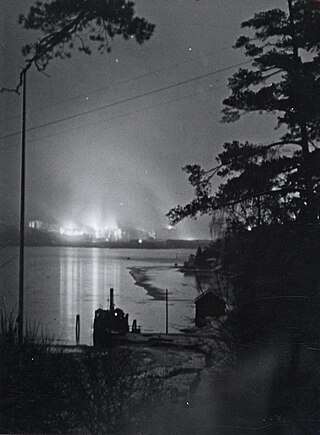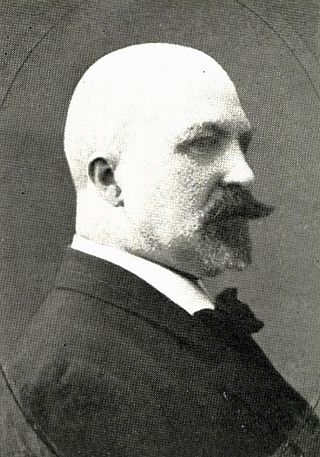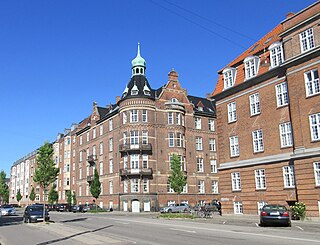
Oslo is the capital and most populous city of Norway. It constitutes both a county and a municipality. The municipality of Oslo had a population of 709,037 in 2022, while the city's greater urban area had a population of 1,064,235 in 2022, and the metropolitan area had an estimated population of 1,546,706 in 2021.

Christiania Theatre, or Kristiania Theatre, was Norway's finest stage for spoken drama from 4 October 1836 to 1 September 1899. It was located at Bankplassen by the Akershus Fortress, in central Christiania. It was the first lasting public theatre in Norway and the national stage of Norway and Oslo during the 19th century.

The Briskeby Line is a line of the Oslo Tramway in Norway. It runs westwards from Jernbanetorget in the city center, passing through the neighborhoods of Briskeby and Uranienborg before reaching its terminus at Majorstuen. The section from Jernbanetorget to Inkognitogata is shared with the Skøyen Line; on this section it connects with the important transport hub Nationatheatret. This part is variously served by route 11, 12 and 13. From the Inkognitogata stop, the line moves through the residential areas around the Royal Palace, in the streets named Riddervolds gate, Briskebyveien, Holtegata and Bogstadveien. The part of the line in Bogstadveien from Majorstuen to Rosenborg is also served by route 19, which operates the Homansbyen Line.
Events in the year 1858 in Norway.

Strandgaten is a street in the city centre of Bergen, Norway, west of the bay of Vågen. It starts at Torgallmenningen and follows the eastern shore of the Nordnes peninsula to Tidemands gate, where it becomes Nordnesgaten. The easternmost quarter of Strandgaten is a regular two-way street, while it is an eastbound one-way street between Tollbodallmenningen and Holbergsallmenningen, and between Østre Murallmenningen and Torgallmenningen. Between Holbergsallmenningen and Østre Murallmenningen the street is pedestrianised. In total, Strandgaten is approximately 1.2 km long.

The fortifications of Copenhagen underwent a comprehensive modernization and expansion in the 17th century. The project was commenced and was largely the masterplan of Christian IV in the early 17th century but was continued and completed by his successors. The new fortifications relied on the existing, medieval fortifications of the city but the fortified area was extended and a defensive ring around the city completed particularly with new edifices facing the sea. The ring fortification consisted of four bastioned ramparts and an annexed citadel as well as various outworks.

The Rodeløkka Line is a former line of the Oslo Tramway of Norway. It was in use from 1900 to 1961, serving the neighborhood of Rodeløkka. After closing, the southern part of the line was designated as part of the Sinsen Line. The Rodeløkka Line was built by Kristiania Kommunale Sporveie (KKS) in 1900, and was subsequently taken over by Kristiania Sporveisselskab (KSS) in 1905. In 1924, the ownership was transferred to Oslo Sporveier. It was served by Line 9 until 1949, when it was replaced by a bus service. In 1955, a new route from Carl Berners plass to Rodeløkka was built, and the line was served by Line 13 until 1961, when the service was terminated. The tracks were removed between 1962 and 1964.

The 1943 Filipstad explosion was a fire in an ammunition store at Filipstad in Oslo on Sunday, 19 December 1943, during the occupation of Norway by Nazi Germany. The fire started during the unloading of ammunition from the transport ship Selma. The estimated amount of exploded ammunition varies from 800 to 1,200 tons. A large number of shells and grenades were tossed into the air and spread over the city. There were around 40 Norwegian casualties and around 75 Germans were killed, and 400 wounded. About 400 buildings were severely damaged.
The Norwegian city of Oslo was founded in the year 1040 under the name Ánslo. After being destroyed by a fire in 1624, during the reign of King Christian IV, a new city was built closer to Akershus Fortress and named Christiania in the king's honour. From 1877, the city's name was spelled Kristiania in government usage, a spelling that was adopted by the municipal authorities only in 1897. In 1925 the city, after incorporating the village retaining its former name, was renamed Oslo.

The 1914 Jubilee Exhibition took place in Kristiania, Norway, from May 5 to October 11, 1914. It marked the centennial anniversary of the 1814 constitution and focused on industry and agriculture. The main location was the grounds of Frogner Manor, in addition to a subsection on shipping at Skarpsno at Frognerkilen. The exhibition opened on 15 May, and was closed on 11 October 1914. The total number of visitors was more than 1.5 million. On 11 October, the final day, more than 100,000 visitors visited the exhibition.
The murder of Knut Grøte took place in Christiania, the capital of Norway, on 10 August 1863. The case ended with the execution of the two killers in April 1864. The public beheadings at Etterstad, which were executioner Samson Isberg's last commissions, were attended by about 5,000 spectators.

Peter Johan Kay Petersen was a Norwegian businessperson, known for his long leadership in the companies Peter Petersen & Co and Nydalens Compagnie as well as the construction of the building complex Victoria Terrasse, formerly known as Petersborg.

Ernst Torp was a Norwegian architect.

Østre Porsgrunn Church is a parish church of the Church of Norway in Porsgrunn Municipality in Vestfold og Telemark county, Norway. It is located in the town of Porsgrunn. It is one of the two churches for the Porsgrunn parish which is part of the Skien prosti (deanery) in the Diocese of Agder og Telemark. The white, concrete church was built in a modern, rectangular design in 2019 using plans drawn up by the architect Espen Surnevik. The church seats about 500 people.

The Great New York City Fire of 1845 broke out on July 19, 1845, in Lower Manhattan, New York City. The fire started in a whale oil and candle manufacturing establishment and quickly spread to other wooden structures. It reached a warehouse on Broad Street where combustible saltpeter was stored and caused a massive explosion that spread the fire even farther.

Henry Bertram Bucher was a Norwegian architect.

Kristianiagade is a street located close to Østerport station in the Østerbro district of Copenhagen, Denmark. Buildings in the street include Domus Medica, a former noble town mansion which now houses the Danish Medical Association. The west side of the street is mostly lined with late 19th century villas of which several now serve as embassies. The street is named after the capital of Norway, Oslo, in recognition of the close ties between the two countries that were part of Denmark-Norway until 1814.

The Calmeyer Street Mission House was a building located at Calmeyers gate no. 1 in Oslo, Norway. The building served as a religious assembly house for Lutheran gatherings in the Oslo neighborhood around Hausmanns gate.

Tollerodden, spelt Tolderodden until 1917, is a peninsula located in the bottom of the Larvik fjord and a part of Larvik town located on the southeast coast of Norway.
















